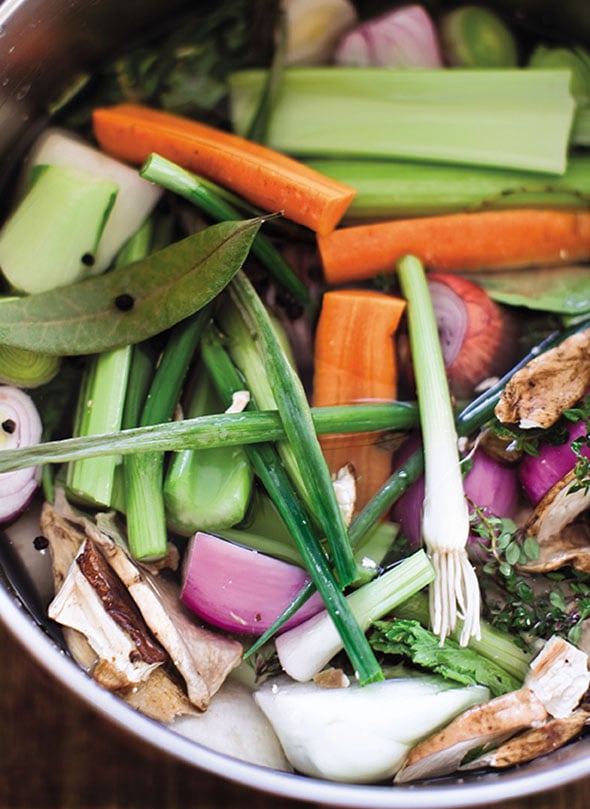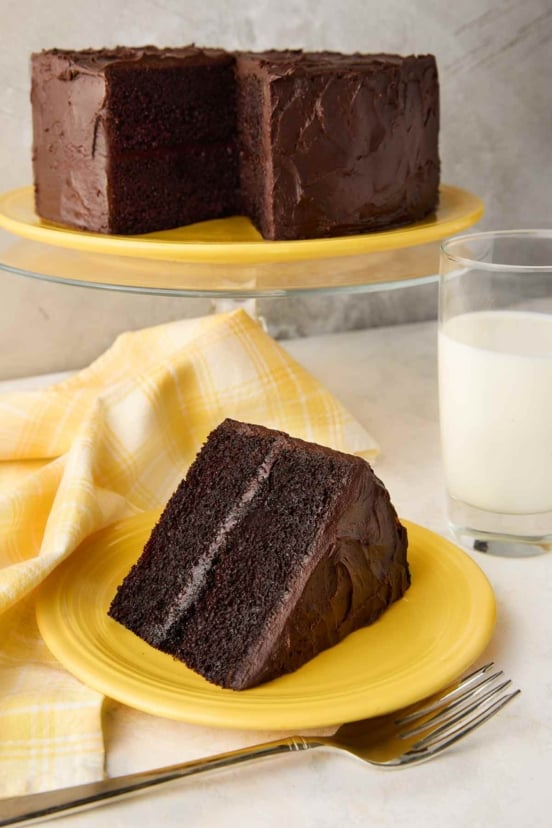
If you collect vegetable scraps throughout the week, you’ll find yourself with more than enough materials to make this sumptuous vegetable broth recipe come Sunday.–Erin Scott
LC Guilty Conscience Note
Do you get clobbered by a guilty conscience each time you let vegetables languish in the fridge? Yeah, us too. “Even when I toss perfectly good veggie scraps into the compost bin, I feel a tug at my conscience telling me the act is wrong,” says the author of this lovely, if loosely defined, vegetable broth recipe. Gah. It’s like she can read our minds. No more guilt, though. Not with this recipe.

Vegetable Broth
Ingredients
- Veggie scraps, such as tough green ends of leeks, bok choy, broccoli florets, turnips and their greens, a wayward carrot, a lonely celery rib, extra onion half, etc. (Avoid using carrot tops in your broth–We think they impart a bitter flavor.)
- Bay leaf
- A few dozen peppercorns
- Sea salt
- A few garlic cloves or shallot
- Herbs of your choosing
- Parmesan rind, (optional)
- Water
Instructions
- Rinse your veggie scraps and toss them into a stock pot. Add the bay leaf, peppercorns, salt, maybe a few cloves of garlic or a shallot, any extra herbs you’ve got lying around, and maybe a rind of Parmesan, if you want. (You can veer from the recipe and use practically anything you want.) Cover everything with plenty of water. Bring the liquid to a boil, then turn the heat down to achieve a gentle simmer. Partially cover the pot and watch your scraps turn into nourishment after a few hours of simmering.
- When the vegetable broth is infused with flavor, turn off the heat and let the liquid cool a bit. Taste and adjust the seasoning, if desired. Use a slotted spoon to scoop the used vegetables right into the compost bin and strain the broth through a fine mesh strainer.
- Use your vegetable broth to make risottos, soups, stews—any recipe you crave. You can stick the broth in lidded containers or resealable plastic bags and stash in the fridge for up to several days or toss it in the freezer until you need it.

Nutrition
Nutrition information is automatically calculated, so should only be used as an approximation.
Recipe Testers’ Reviews
I don’t know why I don’t make this vegetable broth every week. I know there are all sorts of vegetable peelings and trimmings going into the garbage. I know I need stock all the time. And I’ve known how to make vegetable stock for years! The problem is that I only think about it when a recipe calls for it and then it’s too late, so I go with the commercial variety. This recipe is so easy and takes no time at all. Just gather the ingredients you’ve been collecting in your fridge, throw them in a pot of water, and simmer for 2 hours. I used scraps of leek, zucchini, broccoli stems, some slightly aged carrots, celery stalks with their tops, and small amounts of basil, rosemary, thyme, oregano, and chive which I harvested from my terrace pots. My yield from this recipe was 6 cups. I haven’t done anything with the stock yet and most of it’s in my freezer. However, I do see some lovely soups and risottos in my future. What a great way to make some deliciously useful stock without any strange additives and save some money at the same time! I’m pledging to make my own vegetable stock every week or so in time for the holidays when I know I’ll need a small ocean of stock.
I like to see a recipe confirming or suggesting what I intuitively do, giving me confirmation that I am not being silly frugal in my kitchen. One of the reasons I like making vegetable broth is that I’ve only found one brand of store-prepared broth that’s not too sweet. The major failing with most packaged vegetable broths is that they rely too much on onions and carrots and other root vegetables. I stash the excess celery stalks, Parmesan rinds, and leek tops in my freezer for use in chicken or vegetable broth. Since I was using leeks this week, I had several sections of light green leeks saved from a recipe that only wanted the white portion, a half quart celery stalks and leaves, nice tops from some kohlrabi, and half a dozen Parmesan rinds. I’d been saving them to make a broth of just Parmesan, but I thought this combination would work nicely with garlic, shallots, and bay. A teaspoon of kosher salt went in before I remembered to use sea salt, but no harm done, and I used a hefty 1/2 tablespoon of a mixed peppercorn blend. If I didn’t already have a specific soup in mind I probably would have added parsley, lemongrass, or thyme, as I do in my chicken stock. I brought it to boil in a tall pot, reduced it to a simmer, and set it on the back of the stove for a bit over 2 hours. Then I strained it, cooled it, and refrigerated it. Once it’s chilled thoroughly, I skimmed off a little fat—from the Parmesan, I believe.
I realize this is mostly a method rather than a recipe—and that’s the brilliance behind it. You can do this yourself with very little effort and lots of choices that give you total control. (You could add dry mushrooms for a heartier flavor.) Next thing you know, you’ll be doing a court bouillon in your sleep!
How come I never thought of this? I use leftover turkey, chicken, and beef parts to make those broths, but for some reason I’ve never made my own vegetable broth. This recipe was so easy and I would think it would be great to make in the crockpot, too—I will have to try that. And so tasty! I used a little bit of a wide variety of vegetables because I had so many left over veggies in the house and we were getting ready to leave for a few days. Lots of carrots, celery, peppers, haricot verts, mushrooms, and pea pods as well as a few tomatoes that needed to be used. I also cut up 3 onions that were not scraps. I used garlic but no shallots. My fresh herbs have been hanging on a long time this year and thriving so I threw in a bunch of basil, oregano, and parsley. This broth is so yummy I will never buy store broth again! It will be too easy to keep a bag marked scraps in my freezer and just freeze scraps until I have enough to do this again. Just as the recipe says, perfect for soups, risotto, rice…just using such rich, delicious broth with will make any recipe even better. Love this one!
I’ve been doing a version of this vegetable broth for years. I freeze the stock and use it in place of chicken stock in most things. One trick I learned was to take all the scraps, put them in a gallon-size heavy-duty freezer bag, and I add to this bag all week long. Then when it’s time to make the stock, I poke small holes with a sharp knife in the bottom of the bag—about a dozen of them. I then gently lower the bag into room temperature water and bring gently to a simmer. When my stock is well infused, I gently lift the bag out slowly and it drains out all the stock, leaving behind all the vegetable bits eliminating the straining step. Super easy and delicious.
















Love this recipe and the guidance from commenters as well. Most of my past-their-prime vegetables and scraps are blanched, pureed and fed to my dogs, but this would be a great use of the ones they can’t eat (alliums, nightshades, mushrooms).
I find that a lot of vegetable stock recipes don’t really cover the preparation and cleaning step very well. How do you make sure that leek tops are clean before adding them to the stock? My inclination would be to halve them lengthwise and wash the individual leaves in cold water, but many recipes I see picture the whole leek top artfully placed in the pot! Do you just strain the grit out at the end? Would love some guidance on this.
Thanks for your question, Jorgia. The grit in leeks can be so well hidden, so I do separate the leaves and rinse them thoroughly either in a large bowl filled with water or under running water. It’s much easier than straining the finished broth—you’d have to use a super-fine mesh strainer or even double layers of cheesecloth to catch the small particles of dirt. If I can’t use leek tops right away, I put the washed thick leaves in a zip-top bag and keep them in the freezer until I’m ready to make broth.
This smelled so good and I had such high hopes to use it in the Portuguese white bean soup, but maybe I cooked it too long? I usually only do an hour for my veggie stocks. It was very dark and bitter by the end and I ended up having to toss it. I put some leek tops, a stalk of celery, a shallot, a half a red onion, some garlic cloves, green peppercorns, bay leaf and some yellow onion peels I’d been saving. At the end I threw in some thyme I harvested from the outback but really just let it steam bc once I came home to check on it it already smelled too strong. Maybe not enough water? Oh and a parm rind. Thoughts on why it became so bitter?
Jasmine, I’m sorry to hear this didn’t turn out for you. A few different things could have contributed to the stock turning bitter. Occasionally, when cooked too long, they can be bitter. Also, if you used a lot of onion peels, that could have contributed to the bitter flavor. Did you season your broth with salt before simmering? That is also a factor in the flavor. Lastly, it probably could have benefited from some sweeter vegetables, like carrots, to help balance that flavor.
Can’t remember when I last peeled a potato. You know, all the vitamins… Just made a vegan stock, mine are usually chicken, beef, pork, shrimp, fish, etc. Here’s my clean out the fridge vegan stock: onion, celery carrot, escarole, fennel, mushrooms, tomatoes, ginger, garlic, shallots, scallions, black peppercorns, jerusalem artichokes (sun chokes), bay leaf, and potato water (I had made mashed potatoes with cubed unpeeled potatoes simmered in filtered water. I thought it would go cloudy, but it didn’t. No idea why not. Maybe the gentle simmer didn’t release much starch into the water?) OMG, so good! I sipped a cup like tea, divine. There has to be some vitamin and mineral benefit to this stuff. As I tasted it, along the way the fennel seemed to make it a bit too sweet. The escarole’s bitterness offset that. There was a balance that I’ll likely never taste again. My hubby’s complaint is that when I cook something he loves, he probably won’t have it again. Yep, always cleaning out the fridge. Only buy what looks good at a good price. There are a couple of recipes I duplicate, not many. Redfish court bouillon is one. When I make stock I like to steep it like tea. Simmer for a couple of hours, then refrigerate. Bring it back to a simmer, maybe add some more veggies or bits, then strain. I avoid the danger zone on temps by plunking a very clean bottle of frozen water into the middle of a large batch. Did not know I had so much to say about stock or broth. Hope it benefits someone.
nola2chi, thank you, what a treasure you are. I, too, am certain there is benefit to sipping those veggie stocks. And brilliant trick on the bottle of ice to quickly cool the stock. I’ve been pouring my stock into a roasting pan to increase surface area to help it cool quickly, but your way is vastly easier. You’ve already been of benefit to me and, no doubt, to others as well. Thank you.